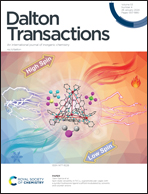Synthesis of NiFe-layered double hydroxides using triethanolamine-complexed precursors as oxygen evolution reaction catalysts: effects of Fe valence†
Abstract
The synthesis of highly efficient NiFe-layered double hydroxides (NiFe-LDHs) to catalyze the oxygen evolution reaction (OER) is urgent and challenging. Herein, NiFe–FeCl3-x and NiFe–FeCl2-x samples (where FeCl3 and FeCl2 represent the Fe sources and x represents the imposed reaction time: 6, 12, and 24 h) were prepared via one-pot hydrothermal synthesis using Fe sources characterized by Fe(III) or Fe(II) valence states. In the presence of triethanolamine, when FeCl3 was used as the Fe source, pure NiFe-LDH was obtained, whose crystallinity increased with increasing hydrothermal treatment time. In contrast, when FeCl2 was used as the Fe source, a mixture of NiFe-LDH, Fe2O3, and trace amounts of Fe3O4 was obtained. The content of NiFe-LDH in the mixture increased under longer hydrothermal treatment and NiFe–FeCl3-x catalysts exhibited better OER performance than NiFe–FeCl2-x catalysts. Specifically, NiFe–FeCl3-6 afforded the highest OER performance with an overpotential of 246.8 mV at 10 mA cm−2 and a Tafel slope of 46.1 mV dec−1. Herein, we investigated the effects of the valence state of Fe precursors on the structures and OER activities of the prepared catalysts; the mechanism of NiFe-LDH formation via hydrothermal synthesis in the presence of triethanolamine was also proposed.



 Please wait while we load your content...
Please wait while we load your content...